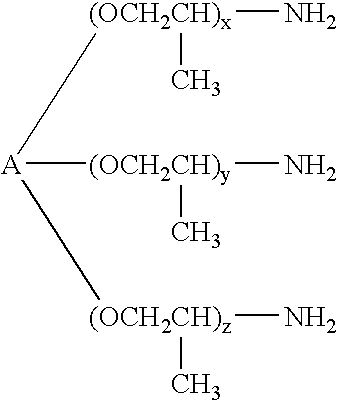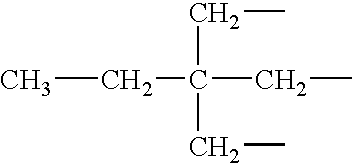Epoxy adhesive having improved impact resistance
a technology of epoxy adhesive and impact resistance, which is applied in the direction of organic non-macromolecular adhesives, cellulose adhesives, adhesive types, etc., can solve the problems of not being able to achieve usable storage stability of single-component systems, significant problems remain in the preparation of high impact epoxy based adhesives, and expandable adhesives
- Summary
- Abstract
- Description
- Claims
- Application Information
AI Technical Summary
Problems solved by technology
Method used
Image
Examples
example 2
Preparation of the Acrylate Terminated Urethane Resin
[0095] The NCO-reactive components (polyols) are mixed for 45 min at 90-100.degree. C. and 0.1-2 mbar to remove water. The polyisocyanate is then added in one portion under nitrogen at 50.degree. C. The reaction mixture is mixed under nitrogen at 70-80.degree. C. to a constant NCO-value. Then the NCO-reactive acrylate is added together with a polymerization inhibitor. Dibutyltin dilaurate (0.01%) is added after 1 hour at 80.degree. C. and the mixing is continued for additional 2 h, then the epoxy resin is added.
5 Weight in Weight Chemical name of Tradename Component grams percent component of Company Acrylate Terminated Urethane Resin A: CAPA 305 275 10.7 Polycaprolactone Solvay Polyol Interox CAPA 220 672 26.2 Polycaprolactone Solvay Polyol Interox MDI 538 21.0 Methylenediphenyldi- isocyanate HPMA 310 12.1 Hydroxypropyl methacrylate EPON 828 769 30.0 DGEBA Resolution Performance Products Acylate Terminated Urethane Resin B: PTHF ...
example 3
Preparation of the Curable Adhesive
[0096] Curable adhesives are prepared by admixing SF-65 with an acrylate-terminated urethane resin and other components listed in Table 1 below with mixing for 45 minutes at a temperature controlled between 27-38 degrees C. (80-100 degrees F.) and pressure of 0.3-3 psi.
6TABLE 1 (all amounts stated are in grams) Component / Adhesive 1 2 3 4 5 6 7 8 9 10 11 12 SF-65 A (Example 1) 500 500 500 500 SF-65 B (Example 1) 500 SF-65 C (Example 1) 500 SF-65 D (Example 1)500 SF-65 E (Example 1) 500 SF-65 F (Example 1) 500 SF-65 G (Example 1) 500 SF-65 H (Example 1) 500 SF-65 J (Example 1) 500 Polydis 3604 EPON 828 100 100 100 100 100 100 100 100 100 100 100 100 EPON 834 DER 351 100 100 100 100 100 100 100 100 100 100 100 100 DER 354 Resin A (Example 2) 100 Resin B (Example 2) 100 Resin C (Example 2) 100 Resin D (Example 2) Resin E (Example 2) Resin F (Example 2) Resin G (Example 2) Resin H (Example 2) Resin J (Example 2) 100 100 100 100 100 100 100 100 100 Resin...
PUM
| Property | Measurement | Unit |
|---|---|---|
| temperatures | aaaaa | aaaaa |
| temperature | aaaaa | aaaaa |
| temperature | aaaaa | aaaaa |
Abstract
Description
Claims
Application Information
 Login to View More
Login to View More - R&D
- Intellectual Property
- Life Sciences
- Materials
- Tech Scout
- Unparalleled Data Quality
- Higher Quality Content
- 60% Fewer Hallucinations
Browse by: Latest US Patents, China's latest patents, Technical Efficacy Thesaurus, Application Domain, Technology Topic, Popular Technical Reports.
© 2025 PatSnap. All rights reserved.Legal|Privacy policy|Modern Slavery Act Transparency Statement|Sitemap|About US| Contact US: help@patsnap.com



